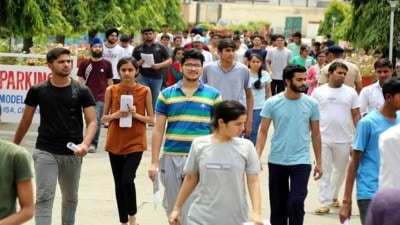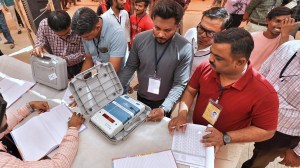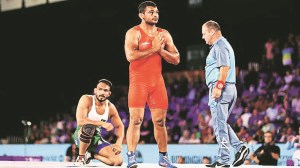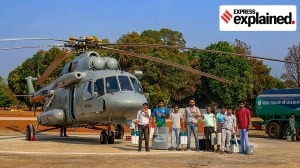- India
- International
Military Digest: With the 72nd Punjabis to Victory
The 72nd fought in Egypt and Palestine as part of Field Marshal Allenby’s victorious army during the First World War. In 1922, after the great reorganisation of the Indian Army, they became the 3rd Battalion of the 2nd Punjab Regiment.
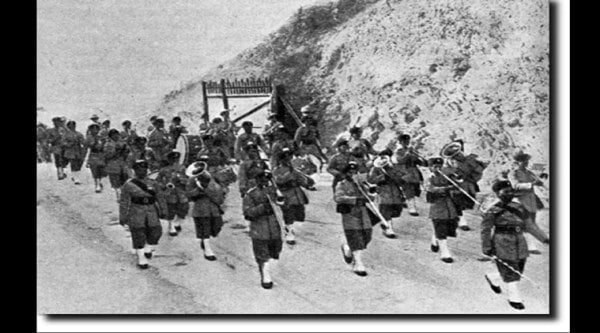 The band of 3/2 Punjab Regiment playing while marching through the Khyber Pass, c1935.
The band of 3/2 Punjab Regiment playing while marching through the Khyber Pass, c1935.
3rd Battalion the Punjab Regiment has been in the news recently with their Ghatak (Commando) Platoon reinforcing 16th Bihar in the Galwan Valley. In the clashes that followed with Chinese soldiers, the Punjabis took a heavy toll of the intruders. Three bravehearts of the battalion – Sepoys Ankush, Gurbinder Singh and Gurtej Singh – made the supreme sacrifice in this clash. The young, handsome Gurtej Singh in particular has caught the fancy of social media-users with many posts lauding his sacrifice and courage in the line of duty.
One of the oldest units of the Army, 3 Punjab came into existence as 16th Battalion, Coast Sepoys in 1767. It served the British well in wars in South India including the campaigns against the formidable ruler-generals Hyder Ali and Tipu Sultan. They made their mark in the 1st and 3rd Burma Wars of the 19th Century sailing to that country and breaking age-old taboos. The regiment was also part of a punitive expedition to Manipur in 1890. From that year they started recruiting Punjabis instead of men from South India. The final break from their roots came in 1903 when they were renamed as 72nd Punjabis with their unique peacock crest. At this stage it’s worth remembering that most of their battle honours and war-experience were earned when their class composition was that of men from what is now Telangana, Andhra Pradesh, Karnataka, Kerala and Tamil Nadu. This is something that they have in common with the senior-most battalions of the Punjab Regiments of both India and Pakistan.
 The handsome martyr Sepoy Gurtej Singh of 3 Punjab – an icon for the times.
The handsome martyr Sepoy Gurtej Singh of 3 Punjab – an icon for the times.
The 72nd fought in Egypt and Palestine as part of Field Marshal Allenby’s victorious army during the First World War. In 1922, after the great reorganisation of the Indian Army, they became the 3rd Battalion of the 2nd Punjab Regiment. In 1935, 3/2 Punjab as they were then known took part in the Loe Agra operations on the North-West Frontier against rebellious tribesmen. Here occurred a battle, albeit small in scale but reflecting to me the true spirit of the regiment – the Defence of Kila Hari.
Valour of a high order was shown in this action. ‘B’ Company of the battalion commanded by Subedar Hari Singh held an isolated post at a height of 1,450 metres on the eastern edge of a ridge overlooking the Loe Agra salient some 20 kilometres from Malakand. The whole Frontier was in a tumultuous state with the tribesmen showing a high degree of belligerence. On the night of 5th/6th April the picket was attacked by 1,000 Shamozai tribesmen. Owing to their overwhelming superiority (the post had only a hundred odd men) the unexpectedly well-led tribal Lashkar managed to close in to the outer defences.
There was hand-to-hand fighting involving revolvers, bayonets, knives and even stones. This lasted an incredible ten hours. It was one of the most ferocious and sustained assaults ever launched by tribesmen in the whole history of military operations on the Frontier. In spite of that the Punjabis held firm with Jemadar Mohammed Baksh and his section of .303-inch Vickers machine-guns playing a major role in beating off attack after attack. Taking advantage of their numerical strength the Shamozais pressed home the assault every fifteen minutes only to be repulsed by the determined Punjabis. This lasted until midnight.

The defenders held their ground steadfastly even as attacks continued till the breaking of dawn. As he personally moved a Lewis-gun (the light machine-gun used by the Indian Army till the late 30s) to a flank to take on the Pakhtoons with enfilade fire, Subedar Sham Singh was fatally wounded. The tribals dispersed at daybreak leaving 28 of their number dead and 7 wounded in and around the post. Three of the Punjabis were killed and seven wounded.
The low casualties and effective defence of the post in the face of overwhelming odds is attributable to the Punjabis’ excellent fire discipline and the control exercised by section and platoon commanders and above all by the company commander, Subedar Hari Singh himself. The defenders’ valour and fighting spirit was recognised by the award of the Indian Order of Merit to Subedar Hari Singh and three others. Four non-commissioned officers (NCOs) were rewarded for their leadership with the Indian Distinguished Service Medal. In a lasting tribute the picquet was thereafter referred to as Kila Hari Singh after its formidable commander (he retired as an honorary Captain). The battalion celebrates the Defence of Kila Hari as their battle honour day on 6th April every year. Interestingly, Major Kuldip Singh Chandpuri was faced with a similar situation while facing fearful odds in 1971 at Longewala. A former officer of 3 Punjab himself he motivated his men by reminding them of the gallant stand of his old battalion at Kila Hari in 1935. As we know his company beat off a hugely numerous Pakistani force.
This action and the excellent service of the battalion led to a life-long association with the Nowshera Brigade commander, later to earn fame in World War Two as Field Marshal Earl Alexander of Tunis. So impressed was he that he assumed the Colonelcy of 3/2 Punjab and later that of the entire 2nd Punjab Regiment. After Independence he became the regiment’s Honorary Colonel, an appointment he retained throughout his life. During the Second World War the battalion had the distinction of fighting both in North Africa and Burma and finished the conflict laden with honours.
Becoming simply 3 Punjab after Independence the battalion took part in the Hyderabad Police Action. Showing its versatility, they had the honour of constructing the highest airfield (at 14,250 feet above sea level) in the world at Chushul in 1951-52 not far from the scene of their latest operational deployment. This was applauded by no less a personage than the then prime minister, Jawaharlal Nehru. The unit had a tenure with the United Nations Emergency Force in Gaza in 1965-66.
Onwards to the 1971 war:3 Punjab as part of 8 Mountain Division played a major role in operations in Bangladesh. These resulted in the capture of Maulvi Bazaar, the reduction of Sylhet and the bottling up of Pakistani 14 Division preventing it from withdrawing to make a last-ditch stand in Dhaka leading to the general surrender. The battalion took part in Operation Pawan in Sri Lanka with the Indian Peace Keeping Force (IPKF) in 1987-90. It was also deployed at Kargil during the conflict in 1999. 3 Punjab’s track record in service in counter-insurgency and in the no-peace, no-war environment of the LOC and LAC is impressive indeed.
The battalion has recently been de-inducted from the Northern Glacier in Siachen (considered the toughest area to serve in). We look forward to them winning further laurels if and when push comes to shove in Eastern Ladakh.
Eastern Ladakh Sitrep
There has been a gradual cooling down of the tense situation in Eastern Ladakh mainly because of the protracted military commanders-level talks for de-escalation and disengagement. Meanwhile the Chinese remain in control of our territory in the Eight Fingers area, Hot Springs and most significantly the Galwan Valley. They are poised dangerously close to vital communication links in the Depsang Plains. My estimate based on open sources and the pattern of their previous deployments is that the People’s Liberation Army (PLA) has two brigades with armour in place opposite Daulet Beg Oldi (DBO). Similarly, there are two more brigades deployed in the Galwan Valley. This makes four in total in the northern half of the conflict zone. A fifth combined-arms brigade mans the Demchok sector. The Border Defence Regiment (very much a part of the regular ground forces, don’t be fooled by the deceptive title) normally managing the Line of Control (LAC) is now positioned in Hot Springs and Pangong Tso it is learnt. There are of course some unverified reserves backing up this force and deployed in rear areas.
A thick veil of secrecy shrouds the Indian response and deployment. However, one estimates that in addition to XIV Corps’ peace-time deployment and reserves, fully acclimatised and mountain-trained divisions are now either confronting the Chinese or in jumping-off points ready to pounce on any incursion or take the offensive against the intruders. Additional units of armour and mechanised infantry are also in readiness to take the war to the enemy giving the XIV Corps commander that much-needed manoeuvrist edge. The IAF’s air superiority and ground-attack assets are only a short flying time away.
Chinese information warfare units are very active. Taking advantage of the vibrant media presence (including the ubiquitous social media) in the democracy that is India they’re busy spreading disinformation. One piece of discredited information is to the effect that no less than 40 Chinese Chengdu J10 multi-role fighter aircraft had landed at Skardu airbase in Pakistani-Occupied Gilgit-Baltistan (POGB) on 21st June. Other rumours which have been spread talk authoritatively of the PLA (Chinese) Air Force taking over Pakistani airfields in Sind and Balochistan for operations against the Indian heartland. Obviously, the intention is to cause panic and influence negotiations. Despite all these attempts at sowing confusion the Indian armed forces’ morale is high.
The PLA’s Strategic Support Force
I’ve always pointed to the uneven nature of the Chinese armed forces with a deficiency in the quality of human resources being the most glaring. Aggressive intentions on their part can easily be countered by our military. But Chinese advances and intentions in recent years in non-contact warfare cannot be discounted. They are ignored at our peril. The PLA’s Strategic Support Force (SSF) combining all cyber, space, electronic warfare and information operations assets is a formidable body. In the estimation of most knowledgeable observers they are far ahead of us mainly because of a lack of attention on our part to these fields of modern warfare.
The SSF was set up as recently as 2018 as part of the first wave of Chinese military reforms. The force consists in the main of two operational departments. The Space Systems Department reflects the importance being accorded by the Chinese to this emerging arena of warfare. It is the consolidation of all of the PLA’s space-based C4ISRT (Command, Control, Communications, Computers, Surveillance, Reconnaissance and Targeting) systems.
The second force, the Network Systems Department integrates all the hitherto independent and constantly competing (and bickering!) information operations and cyberwarfare capabilities. If normally well-informed Western think tanks are to be believed the Department has massive operational resources. Consequently, its capabilities are very substantial. Just to give the reader an idea it is estimated by Foreign Policy magazine that China’s hacker army is composed of anywhere between 50,000 and one lakh individuals. Overlapping missions between the two departments are – space launch, space telemetry, tracking and control, space C4ISR, counter-space, strategic intelligence, cyber-operations, electronic warfare and psyops.
Our hesitant efforts in harnessing our energies to non-contact warfare are still mired in the perennial military-bureaucratic conflict with the politicians hesitant as always to cut the Gordian knot of ineptitude, laissez-faire and sloth.
Please contact the writer with your military story on msbajwa@gmail.com or 093161-35343
Apr 18: Latest News
- 01
- 02
- 03
- 04
- 05











